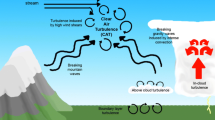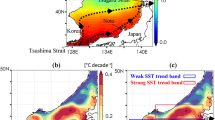Abstract
This paper presents a study on drag coefficients under typhoon wind forcing based on observations and numerical experiments. The friction velocity and wind speed are measured at a marine observation platform in the South China Sea. Three typhoons: SOULIK (2013), TRAMI (2013) and FITOW (2013) are observed at a buoy station in the northeast sea area of Pingtan Island. A new parameterization is formulated for the wind drag coefficient as a function of wind speed. It is found that the drag coefficient (C d ) increases linearly with the slope of 0.083×10−3 for wind speed less than 24 m s−1. To investigate the drag coefficient under higher wind conditions, three numerical experiments are implemented for these three typhoons using SWAN wave model. The wind input data are objective reanalysis datasets, which are assimilated with many sources and provided every six hours with the resolution of 0.125°×0.125°. The numerical simulation results show a good agreement with wave observation data under typhoon wind forcing. The results indicate that the drag coefficient levels off with the linear slope of 0.012×10−3 for higher wind speeds (less than 34 m s−1) and the new parameterization improvese the simulation accuracy compared with the Wu (1982) default used in SWAN.
Similar content being viewed by others
References
Alamaro, M., Emanuel, K., Colton, J., McGillis, W., and Edson, J. B., 2002. Experimental investigation of air-sea transfer of momentum and enthalpy at high wind speed. 25th Conference on Hurricanes and Tropical Meteorology, American Meteorology Society, San Diego, CA, 667–668.
Alves, J. H. G. M., and Banner, M. L., 2003. Performance of a saturation-based dissipation-rate source term in modeling the fetch-limited evolution of wind waves. Journal of Physical Oceanography, 33: 1274–1298.
Booij, N., Ris, R. C., and Holthuijsen, L. H., 1999. A third-generation wave model for coastal regions: 1. Model description and validation. Journal of Geophysical Research: Oceans (1978-2012), 104 (C4): 7649–7666.
Cavaleri, L., and Malanotte-Rizzoli, P., 1981. Wind wave prediction in shallow water: Theory and applications. Journal of Geophysical Research, 86 (C11): 10961–10973.
Emanuel, K. A., 2003. A similarity hypothesis for air-sea exchange at extreme wind speeds. Journal of the Atmospheric Sciences, 60: 1420–1428.
Garratt, J. R., 1977. Review of drag coefficients over oceans and continents. Monthly Weather Review, 105: 915–929.
Geernaert, G. L., 1988. Measurements of the angle between the wind vector and wind stress vector in the surface layer over the North Sea. Journal of Geophysical Research, 93: 8215–8220.
Golbraikh, E., and Shtemler, Y. M., 2015. Foam input into the drag coefficient in hurricane conditions. Dynamics of Atmospheres and Oceans, 73: 1–9, DOI: 10.1016/j.dynatmoce.2015.10.005.
Hasselmann, K., 1974. On the spectral dissipation of ocean waves due to white-capping. Boundary-Layer Meteorology, 6 (1-2): 107–127.
Holthuijsen, L. H., Booij, N., and Ris, R. C., 1993. A spectral wave model for the coastal zone. In: Ocean Wave Measurement and Analysis (1993). ASCE, 630–641.
Janssen, P. A. E. M., 1991. Quasi-linear theory of wind-wave generation applied to wave forecasting. Journal of Physical Oceanography, 21: 1631–1642.
Komen, G. J., Hasselmann, K., and Hasselmann, K., 1984. On the existence of a fully developed wind-sea spectrum. Journal of Physical Oceanography, 14 (8): 1271–1285.
Large, W. G., and Pond, S., 1981. Open ocean momentum flux measurements in moderate to strong winds. Journal of Physical Oceanography, 11: 324–336.
Liu, B., Guan, C. L., and Xie, L., 2012. The wave state and sea spray related parameterization of wind stress applicable from low to extreme winds. Journal of Geophysical Research: Oceans, 117: C00J22, DOI: 10.1029/2011JC007786.
Moeini, M. H., Etemad-Shahidi, A., and Chegini, V., 2010. Wave modeling and extreme value analysis off the northern coast of the Persian Gulf. Applied Ocean Research, 32 (2): 209–218.
Moon, I.-J., Ginis, I., and Hara, T., 2004. Effect of surface waves on air-sea momentum exchange. Part II: Behavior of drag coefficient under tropical cyclones. Journal of the Atmospheric Sciences, 61: 2334–2348.
Oey, L.-Y., Ezer, T., Wang, D.-P., Fan, S.-J., and Yin, X.-Q., 2006. Loop Current warming by Hurricane Wilma. Geophysical Research Letters, 33: L08613, DOI: 10.1029/2006 GL025873.
Powell, M. D., Vickery, P. J., and Reinhold, T. A., 2003. Reduced drag coefficient for high wind speeds in tropical cyclones. Nature, 422: 279–283.
Reichl, B. G., Hara, T., and Ginis, I., 2014. Sea state dependence of the wind stress over the ocean under hurricane winds. Journal of Geophysical Research: Oceans, 119: 30–51.
Ris, R. C., Holthuijsen, L. H., and Booij, N., 1994. A spectral model for waves in the near shore zone. Proceedings Coastal Engineering, 1 (24): 68–78.
Ris, R. C., Holthuijsen, L. H., and Booij, N., 1999. A third-generation wave model for coastal regions: 2. Verification. Journal of Geophysical Research: Oceans (1978-2012), 104 (C4): 7667–7681.
Sanford, T. B., Price, J. F., Girton, J. B., and Webb, D. C., 2007. Highly resolved observations and simulations of the ocean response to a hurricane. Geophysical Research Letters, 34 (13): L13604, DOI: 10.1029/2007GL029679.
Shen, H., He, Y. J., and Perrie, W., 2009. Speed ambiguity in hurricane wind retrieval from SAR imagery. International Journal of Remote Sensing, 30 (11): 2827–2836.
Smith, S. D., 1980. Wind stress and heat flux over the ocean in gale force winds. Journal of Physical Oceanography, 10: 709–726.
Srivastava, P., and Sharan, M., 2015. Characteristics of drag coefficient over a tropical environment in convective conditions. Journal of the Atmospheric Sciences, 72 (12): 4903–4914, DOI:10.1175/JAS-D-14-0383.1.
Tolman, H. L., 1992. Effects of numerics on the physics in a thirdgeneration wind-wave model. Journal of Physical Oceanography, 22 (10): 1095–1111.
WAMDI Group, 1988. A third generation ocean wave prediction model. Journal of Physical Oceanography, 18 (12): 1775–1810.
Wu, J., 1982. Wind-stress coefficients over sea surface from breeze to hurricane. Journal of Geophysical Research, 87: 9704–9706.
Yan, L., 1987. An improved wind input source term for third generation ocean wave modelling. Scientific report WR-No87-8, De Bilt, The Netherlands, 87–88.
Zedler, S. E., Niiler, P. P., Stammer, D., Terrill, E., and Morzel, J., 2009. Ocean’s response to Hurricane Frances and its implications for drag coefficient parameterization at high wind speeds. Journal of Geophysical Research: Oceans, 114 (C4):C04016–C04034, DOI: 10.1029/2008JC005205.
Zijlema, M., and van der Westhuysen, A. J., 2005. On convergence behaviour and numerical accuracy in stationary SWAN simulations of nearshore wind wave spectra. Coastal Engineering, 52 (3): 237–256.
Zijlema, M., Van Vledder, G. P., and Holthuijsen, L. H., 2012. Bottom friction and wind drag for spectral wave models. Coastal Engineering, 65 (7): 19–26.
Acknowledgments
This study is supported by the National Natural Science Foundation of China (Nos. 41276015, 51509226), the Fundamental Research Funds for the Central Universities (No. 201513040), and Open Science Foundation of Key Laboratory of Digital Ocean, SOA (No. KLD0201404).
Author information
Authors and Affiliations
Corresponding author
Rights and permissions
About this article
Cite this article
Cao, H., Zhou, L., Li, S. et al. Observation and numerical experiments for drag coefficient under typhoon wind forcing. J. Ocean Univ. China 16, 35–41 (2017). https://doi.org/10.1007/s11802-017-3091-4
Received:
Revised:
Accepted:
Published:
Issue Date:
DOI: https://doi.org/10.1007/s11802-017-3091-4




